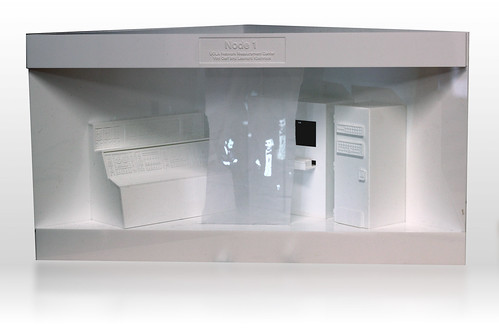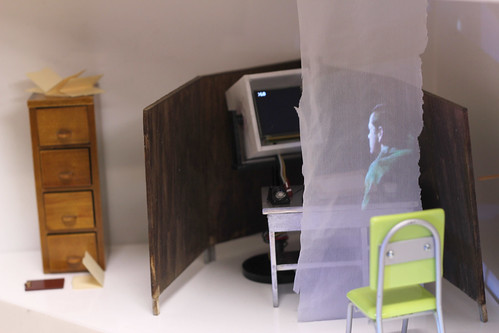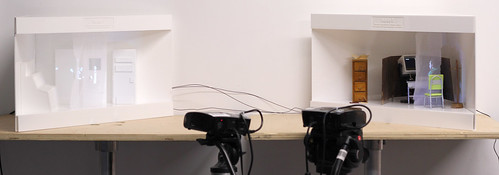On October 29, 1969, at 10:30pm grad students and professors at UCLA’s Network Management Center and Stanford’s Augmentation Research Center began the first ever test of the ARPANet, the initial incarnation of today’s Internet.
My sculpture, “LO: October 29, 1969”, memorializes this moment. It uses laser-cut plexiglass, OLED screens, dollhouse furniture, composited educational films, and Baroque theatrical lighting effects to reenact the birth of our now ubiquitous online world.
LO detail. Node 1: The UCLA Network Management Center
It was a modest moment, lacking ceremony, this first ARPANet transmission. The UCLA and Stanford teams connected their IMPs (Interface Message Processors) and the UCLA team begin the process of logging into Augment’s NLS collaboration system. The two teams were in phone contact with each other; as the UCLA team typed each letter of the initial login command (L – O – G – I – N), they verbally confirmed its arrival in the north.
LO detail. Node 2: The Stanford Augmentation Research Center
However, something, as it always does in software tests, went wrong. When the UCLA team typed the “G”, the Augment system attempted to auto-complete the command to “LOGIN”, sending back too many characters down the ARPANet connection, causing the UCLA system to crash, which then brought down the Augment system in turn.
‘LO’: October 29, 1969 on Vimeo
This moment resonates with me as an origin narrative for a number of reasons. First, as a maker of interactive sculptures that rely on touchy, error-prone technology, I can identify closely with the bug that brought down the system on its first run. I’ve experienced exactly parallel problems in getting hardware projects to communicate with software. I find the presence of such a simple “beginner’s bug” at this epochal moment personally touching.
Secondly, and more importantly, the contrast between the cultures of the two labs on either side of this first Internet connection dramatizes a tension in technocultural development that persists and continues to shape our world today. Namely, the tension between the military industrial complex that funded the personal computing and networking technologies at the heart of our contemporary world and the counterculture which gave them their meaning.
Both the UCLA and Stanford labs received much of their funding from ARPA, the Defense Department’s Advanced Research Projects Agency. Though ARPA’s leadership interpreted its mandate broadly and creatively, their fundamental goals were oriented towards fighting and winning the Cold War. In fact because of this association computer technology was specifically picked out by anti-war protests as an avatar of the establishment’s warmongering. Punch cards were worn in anti-draft protests, students hoping to transfer their inscription of Do Not Fold, Bend, Mutilate or Spindle away from the cards and onto themselves.
However, by 1969 in the Bay Area around Stanford, the counterculture had strongly taken hold. And the Augment lab was not isolated from this change. Doug Engelbart, the lab’s visionary founder, and other of its lead engineers used LSD as part of their design process. The hippie encounter group EST was involved in the management of the lab. Leading countercultural figures, such as Stewart Brand and Ken Kesey, were frequent visitors.
Instead of seeing the computer as simply a tool of “The Man”, the Augment community began to imagine the computer as a consciousness expanding experience similar to other countercultural tools such as psychedelic drugs and communal living.
It is out of the synthesis of these two influences that the modern personal computer and internet cultures emerged: cutting-edge technology used towards the ends of advancing human communication, collaboration, creativity, and community. And it was at Doug Engelbart’s Augment lab that this synthesis first emerged. For the first time, rather than treating its users as information to be processed or cards to be punched, the Engelbart’s system imagined them as countercultural individual striving for expanded consciousness.
While the comparison is not entirely fair to the UCLA lab, LO attempts to emphasize this divide through the material in which each of the labs is rendered. The UCLA lab comes to represent the existing fully military industrial computing approach. That full side of the sculpture is manufactured out of laser-cut white plexiglass. Everything is clean, symmetrical, inhuman.
LO detail. The UCLA Network Management Center.
Further, for the figures in this half of the sculpture, I composited the heads of Vint Cerf and Lenard Kleinrock, two important figures in the creation of the ARPANet, onto a prmotional film from the 1960s explaining the technical workings of timesharing. The footage is black and white and the characters are dressed rather conservatively in suits, ties, and bow ties. I then projected that footage onto a scrim within the sculpture so the figures would appear to be floating within the scene, a technique derived from similar tricks used in Baroque theatre and magic lantern shows from the 18th and 19th centuries.
The Augment side of the sculpture, by contrast, is built of modified doll furniture and props as well as hand-fabricated pieces. It is messy, colorful, and lived-in. I based its appearance as closely as I could on actual photographs taken of the Augment lab in the 60s, archived on Henry Lowood’s terrific MouseSite.
The animation on this side, meant to represent Bill English, one of Engelbart’s chief assistants in charge of hardware, was extracted from a 1968 film imagining the different ways men and women will use technology in “the future”. It has the saturated color palette much associated with both that time and with psychedelic art of the period.
Here is a video of both half of the pieces together as installed at the 2010 ITP Winter Show. You can also hear me hoarsely explaining the piece to a visitor, articulating some of the ideas I have discussed here:
‘LO’: October 29, 1969 detail on Vimeo
To close, a few final technical notes on the piece’s execution. The two sculptures were designed to be halves of a square box. Inside of each one is an Arduino controlling the OLED screens in order to synchronize the display of the characters to represent the transmission of data from UCLA to stanford (see the first video I posted above). The OLED screens, while producing exactly the appearance that I wanted, turned out to be extremely fragile and expensive.
The Arduino in the UCLA side also communicated via USB with a Processing sketch that drove the videos projected onto both sculptures. Synchronization was achieved by having the Processing sketch send a serial message to the UCLA Arduino which would alter its OLED screen and then pass the message on to the Stanford Arduino, hence keeping the video and both of the sculptures in sync. Getting the Processing sketch to successfully play back both pieces of video without crashing was one of the most difficult technical obstacles in creating this project. And, in future installations, I will likely eliminate that component as the timing between the video and the OLED screens does not need to be as precise as I initially thought and using simple PICO projectors driven off of SD cards would allow me to eliminate the computer altogether, dramatically simplifying the setup and robustness of the project.
More photographs of the piece under construction (including details of all of the laser cut components) are available in the LO: October 29, 1969 flickr set.
I’ll be showing this piece beginning February 11 at Ventana244 Gallery in Williamsburg. More details about that show here.
LO: October 29, 1969 installed at the 2010 NYU Winter Show






These ones you probably shouldn’t throw away. Nice work!